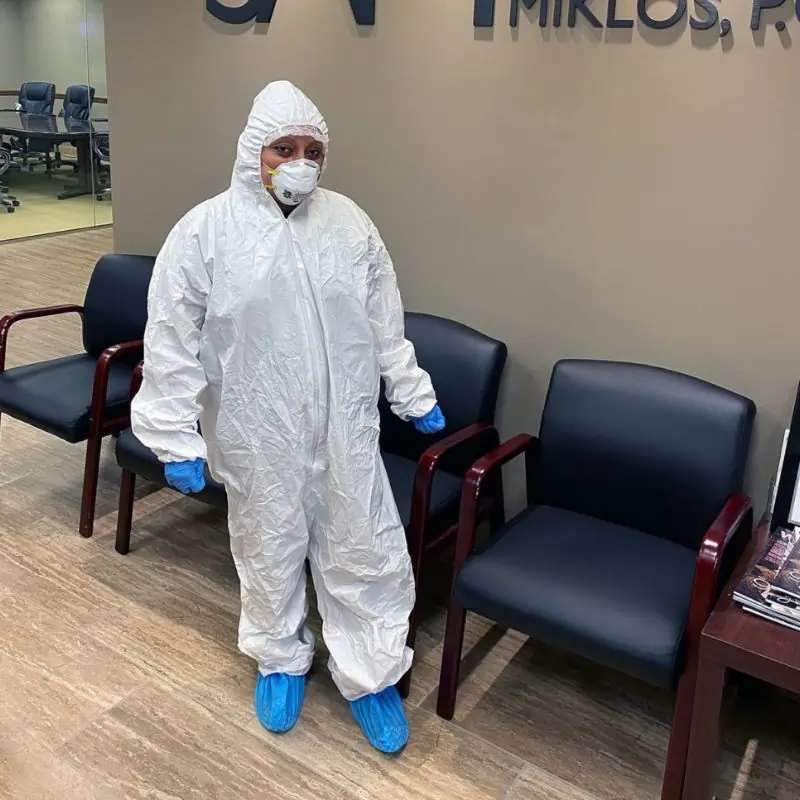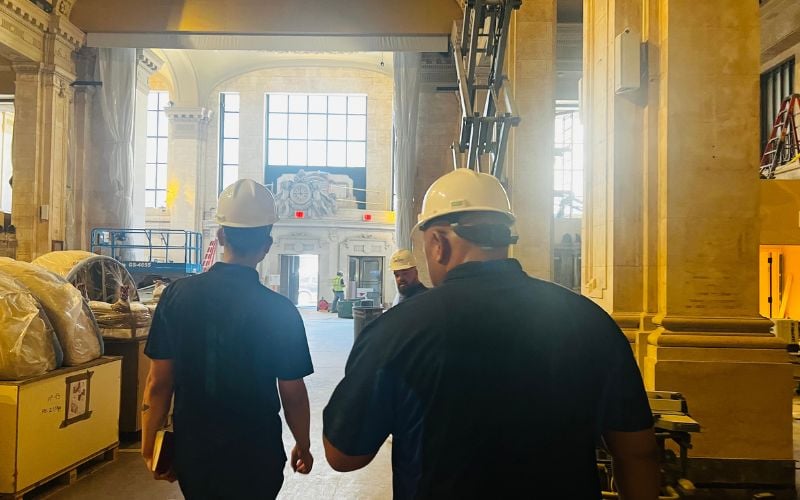In the world of commercial construction, professional post-construction cleaning services is as critical as the build itself. Construction dust not only poses a hazard to health but can also impact the functionality and longevity of the finished building. Understanding the right cleaning protocols ensures a safer environment for workers and the eventual occupants of new space on the premises.
Best way to clean construction dust
Effective dust control starts with preparation. Essential equipment includes HEPA-filtered vacuums, which trap fine particles without releasing them back into the air, and personal protective gear such as masks, goggles, and gloves to safeguard the professional construction cleaners.

Step-by-Step Construction Cleaning Process
- Initial Sweep: Start by removing larger debris. Push brooms and dustpans are effective for this stage, clearing the way for more detailed cleaning.
- Clean Air Vents & Replace Filters: Construction dust will have settled in the ventilation system and filters during the construction process and it is crucial to remove construction dust before the final cleaning takes place as the dust will otherwise be blown out into the cleaned space.
- Wiping Surfaces: Moist cloths or specialized wiping tools should be used to clean all surfaces, including walls and fixtures, to ensure all construction dust is removed.
- Detailed Vacuuming: Employ HEPA-filtered vacuums to capture finer dust. These vacuums are essential for preventing construction dust from becoming airborne again.
- Special Attention Areas: Pay particular attention to vents, light fixtures, appliances and other areas where construction dust might accumulate but is often overlooked.
For more detailed information please visit our articles on commercial construction cleanup, the 3 phases of post construction cleaning, construction cleaning checklist, and what is post-construction cleaning where we share our practical process for excellent and expertise in the industry.
Best way to clean construction dust off walls
Cleaning construction dust off walls effectively requires a methodical approach to prevent harmful particles in the dust from spreading further and to ensure all residues are removed. Here’s a step-by-step guide to achieve the best results:
- Preparation: Before starting the construction cleaning process, ensure that the room is ventilated with fresh air. Open windows and doors to allow airflow, which helps reduce the dust concentration in the air. Make sure to start the ventilation to clear and clean the air ducts as dust particles will have settled in the ventilation system.
- Dry Dusting: Begin by gently removing loose construction dust from the wall with a dry microfiber cloth or a soft brush attachment on a vacuum cleaner. This initial step helps in removing the bulk of the dust without smearing it into the wall surface. Make sure you clean construction dust in ALL hard to reach places such as cabinets inside out, ducts under the ceiling and behind cabinets etc.
- Damp Wiping: After the initial dry dust removal, use a damp microfiber cloth to wipe down the walls. It’s important to use just enough moisture to capture the dust without saturating the wall. Excessive water can damage paint or wallpaper and encourage mold growth.
- Mild Cleaning Solution: For stubborn dust or greasy residues, a mild detergent mixed with water can be used. Apply the solution with a sponge or cloth, gently working in sections and wiping in a downward motion. Avoid harsh chemicals as they can strip paint or damage finishes.
- Rinsing: Once the walls are cleaned, go over them with a clean, damp cloth to remove any soap residue. This step is crucial to prevent streaks and to ensure that no cleaning solution remains on the walls.
- Drying: After rinsing, dry the walls with a soft, dry cloth. This helps prevent any lingering moisture, which could be detrimental to the wall surfaces.
- Repeat if Necessary: Depending on the extent of dust accumulation, it might be necessary to repeat the cleaning process to ensure all dust is removed.
- Final Quality Inspection: Once the walls are dry, inspect them for any areas that may have been missed or need additional cleaning. Use a soft brush or cloth to touch up as needed.
By following these steps, you can ensure that the walls are thoroughly cleaned of construction dust and dirt particles preparing them for any further decorating or painting that might be planned.

Best way to clean construction dust from floors
Cleaning dust from floors is essential for maintaining a safe and clean environment on a construction site. Here’s how to effectively remove dust from various types of flooring based on our expertise in commercial floor cleaning:
- Initial Sweep: Start by sweeping the floors with a sturdy broom to collect larger particles and debris. This helps in clearing the surface and making the subsequent steps more effective.
- Vacuuming: Use a vacuum equipped with a HEPA filter to capture finer dust particles. HEPA-filtered vacuums are highly effective in trapping small dust particles that a broom might miss. Ensure to vacuum all corners and edges where dust tends to accumulate.
- Damp Mopping: Once vacuuming is complete, follow up with a damp mop machine with a microfiber mop and a mild detergent solution to capture any remaining dust. The microfiber material is excellent for trapping dust and does not scratch the floor surface. For concrete floors, you may use a slightly more robust detergent to handle the typical residue left after construction.
- Using a Dust Mop: For surfaces like hardwood or tiles, using a treated dust mop can be effective after damp mopping. This type of mop is designed to pick up and hold dust without dispersing it back into the air.
- Rinsing: Rinse the floor with clean water, especially if you have used a detergent. This step is crucial to prevent any residue that could attract more dust or make the floor slippery.

High-Rise Post-Construction Cleaning: Compliance, Coordination, And Cleaning High Rises in New York City and New Jersey areas.
Post-Construction Cleaning Protocols
After dust removal, it’s important to properly dispose of the collected residual dust, and debris. Use sealed bags to prevent any escape during transit. Conducting a final inspection ensures no areas are overlooked, and performing a touch-up clean if necessary guarantees a pristine condition before handing the site over.
Advanced Post-Construction Cleaning Techniques
While traditional sweeping and vacuuming are effective, advanced techniques like wet-washing can also be beneficial, especially in areas with stubborn dust. However, wet methods are only suitable where water will not damage materials or structures. The use of eco-friendly cleaning agents not only protects the environment but also the health of the cleaning crew and future building occupants.
Consider personal protective equipment
Ensuring the safety of construction workers and the cleaning team is paramount. Comprehensive training on the risks associated with construction dust and the correct use of PPE should be mandatory. Regular health monitoring and adopting ergonomic practices help prevent long-term injuries and illnesses.

Regulatory Compliance
First, adhering to OSHA regulations is not just about legal compliance but also about maintaining high standards of health and safety. Detailed documentation of cleaning procedures and adherence to safety standards are vital for regulatory compliance and audit purposes.
Secondly, there are local regulatory guidelines for sorting and disposal of construction dust and debris that should be followed to ensure compliance and excessive cost of disposal from commercial construction sites.

We are experts in construction cleanup
Construction Cleaning in CONNECTICUT
Construction Cleaning in NEW JERSEY
Benefits of hiring a professional post-construction cleaning company
For expert cleaning services that ensure a dust-free and safe construction site, contact Advantage Cleaning. Let us show you how our expertise and commitment to quality make us leaders in the industry. Schedule a consultation or site walk-through today and experience the Advantage Cleaning difference.
FAQ construction dust
Related articles
Challenges Facing Commercial Construction Clean Up & How To Ensure Higher Quality
As a construction project manager, you already juggle an overwhelming number of tasks — from schedules…
Commercial Post-Construction Cleaning Checklist – [Guide]
What is Post-Construction Cleaning & Why It Demands Expertise
What is post-construction cleaning? As a commercial cleaning company with expertise in post-construction cleaning, we…





